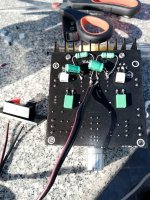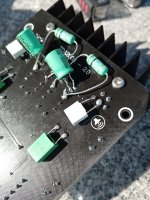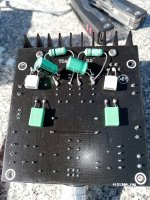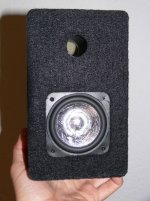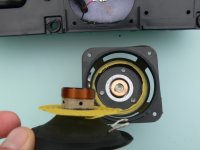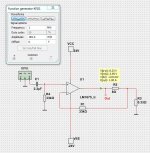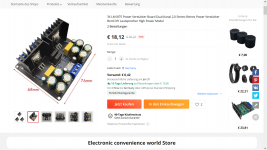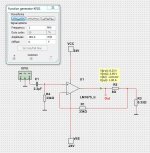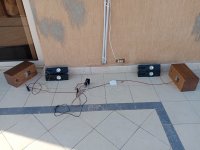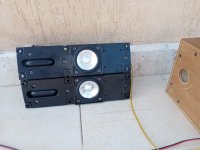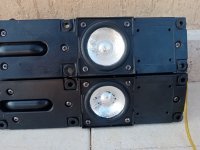We have a proposition for turning the TDA2003 into a "current feedback" design. I am a little bit slow as I am not into electronics and search for the easiest way to get my first experience with this type of amplifier.
If it works we have some fast way to such an amplifier because I found an already assembled item for only ten Euros.
I am a fan of fullrange drivers (one way, large band). All these speakers - especially the cheap ones without copper or faraday ring profit from massive distortion reduction and needed linearization in the highs and lows "for free" if you use a current driven amplifier.
I do not understand why these are not ready made commercially available.
If it works we have some fast way to such an amplifier because I found an already assembled item for only ten Euros.
I am a fan of fullrange drivers (one way, large band). All these speakers - especially the cheap ones without copper or faraday ring profit from massive distortion reduction and needed linearization in the highs and lows "for free" if you use a current driven amplifier.
I do not understand why these are not ready made commercially available.
Ok. I see.These OTAs have peak output current similar to Iset. Max Iset is 2mA. So you would need about a thousand to get speaker-level drive (>10W). You might collapse the tiny market for LM13700.
And there is no easy technical possibility to add some more power with some transistor(s) following the output stage?
Why are there no more powerful chipamps already made for current drive? Like 5, 10 or 20 watts?
TV sets and (cheap) earphones would be candidates for ready made current driven chipamps. Maybe someone from the big companies reads this and realizes this could be a new market.
However, there is no doubt about the sonic benefits of current driven loudspeakers.
Its just testing modified standard schematics to current feedback for the TDA2003.
The change is so simple here that it could be done with two switches:
If R2 ist kept to 0.1 ohms you can change from voltage drive to current drive with one switch putting the louspeaker off the ground. And with the other to connect it to minus of the 470mfd electrolytic.
Fun idea.
Its just testing modified standard schematics to current feedback for the TDA2003.
The change is so simple here that it could be done with two switches:
If R2 ist kept to 0.1 ohms you can change from voltage drive to current drive with one switch putting the louspeaker off the ground. And with the other to connect it to minus of the 470mfd electrolytic.
Fun idea.
Is it possible to put two TDA2003 in parallel? Heard that this is done sometimes with other chip amps. To ameliorate current capability.
If I identify correctly the amplifier topology on Esa Merilainens webpage the amp with TDA2003:
C4 seems not to be a sound bottleneck under current drive:
https://www.current-drive.info/9
Citation
"Using one sided single supply voltage":
An important additional benefit of the current-drive operation is that the non-idealities of the electrolytic capacitor (C3), that is needed for DC blocking, are not able to affect the load current and hence to degrade sound quality, as can happen in a voltage-output amplifier. Also, the current-driven capacitor does not introduce a pole (i.e. a roll-off) in the low-frequency response, as happens in conventional design.
And Merilainen tells that there is a way to use BTL amplifiers for current feedback. Fascinating.
Maybe someone can find out for the TDA2003 how to do it. Principal schematic is on Merilainens website.
C4 seems not to be a sound bottleneck under current drive:
https://www.current-drive.info/9
Citation
"Using one sided single supply voltage":
An important additional benefit of the current-drive operation is that the non-idealities of the electrolytic capacitor (C3), that is needed for DC blocking, are not able to affect the load current and hence to degrade sound quality, as can happen in a voltage-output amplifier. Also, the current-driven capacitor does not introduce a pole (i.e. a roll-off) in the low-frequency response, as happens in conventional design.
And Merilainen tells that there is a way to use BTL amplifiers for current feedback. Fascinating.
Maybe someone can find out for the TDA2003 how to do it. Principal schematic is on Merilainens website.
No need to, TDA2003 was designed to drive 2 ohm loads.Is it possible to put two TDA2003 in parallel? Heard that this is done sometimes with other chip amps. To ameliorate current capability.
Its problem is not standing highish voltages (>16V) since from day 1 it was designed for car amps, current capability was generous (for the intended use)
In fact, datasheet allows 1.6 ohm loads, go figure, since one old standard was 3.2 ohm speakers so it could drive two of them in parallel.
Now I soldered everything.
0.22 mfd foil directly to the pins 3 and 5 of each TDA2003 chip.
220mfd additionally to 220mfd on the board to come closer to the regular 470mfd.
1mfd foil for coupling capacitor on the output. On my board it's 2000mfd 25v.
0.1 ohm in parallel to the highish 4.7 ohms which are in the datasheet schematic 2.2 ohms.
Current feedback wiring (minus for the loudspeaker) derived from the point behind 220 ohms. Omitting the minus for the loudspeaker on the board.
Will make a soundtest now.
With one loudspeaker connected to the board and the other to the current feedback. Just to have a comparison.
0.22 mfd foil directly to the pins 3 and 5 of each TDA2003 chip.
220mfd additionally to 220mfd on the board to come closer to the regular 470mfd.
1mfd foil for coupling capacitor on the output. On my board it's 2000mfd 25v.
0.1 ohm in parallel to the highish 4.7 ohms which are in the datasheet schematic 2.2 ohms.
Current feedback wiring (minus for the loudspeaker) derived from the point behind 220 ohms. Omitting the minus for the loudspeaker on the board.
Will make a soundtest now.
With one loudspeaker connected to the board and the other to the current feedback. Just to have a comparison.
Attachments
First listening test: works good
Brings the Pioneer fullranges I wrote here about to high end level.
You do not need to add any highs any more. Instead of adding highs I have to put down 8khz by one or two DBs and 3khz by one db.
Bass is controlled and correct but not fat or too much at all. Speakers are now not close against the wall. If put close to the wall no extra bass is necessary.
As expected distortion gets down and brings this speaker to a new level of quality sound.
Quite happy with it!
Brings the Pioneer fullranges I wrote here about to high end level.
You do not need to add any highs any more. Instead of adding highs I have to put down 8khz by one or two DBs and 3khz by one db.
Bass is controlled and correct but not fat or too much at all. Speakers are now not close against the wall. If put close to the wall no extra bass is necessary.
As expected distortion gets down and brings this speaker to a new level of quality sound.
Quite happy with it!
Attachments
With the speakers down put on the floor no eq correction necessary.
I am quite impressed. Sounds very classy.
I am quite impressed. Sounds very classy.
Today I tried another loudspeaker which has faraday rings - 8cm fullrange drivers - diaphragm covered with aluminium foil.
Current feedback with the TDA2003 has sonical benefits also for this kind of loudspeakers with faraday rings. Which already have less distortion.
It really brings these to a new acoustic level.
At all frequencies it is clearly audible. The bass becomes much better, too.
In my opinion there is no problem in the bass with fullrange loudspeakers with current feedback. More bass is only the compensation for the shy bass of many fullrange drivers. The same with the highs.
Current feedback with the TDA2003 has sonical benefits also for this kind of loudspeakers with faraday rings. Which already have less distortion.
It really brings these to a new acoustic level.
At all frequencies it is clearly audible. The bass becomes much better, too.
In my opinion there is no problem in the bass with fullrange loudspeakers with current feedback. More bass is only the compensation for the shy bass of many fullrange drivers. The same with the highs.
Attachments
"I will try out now current drive or current feedback with the LM1875."
or? Will you try 2 things or are they the same?
I'm interested in making a LM1875 amp perform current drive - i.e. high output impedance....
I have purchased a LM1875 based amp ans waiting for delivery...
//
or? Will you try 2 things or are they the same?
I'm interested in making a LM1875 amp perform current drive - i.e. high output impedance....
I have purchased a LM1875 based amp ans waiting for delivery...
//
I bought now three stereo amplifiers LM1875 which I will try to make work with current drive/current feedback like in the schematic which I posted from this thread here. Three for 18 Euros from Aliexpress (directly from China). It will take some time until the amps arrive.
They are ready for use with a transformer 15-0-15 which has to be added. Hope I can do it. I will have to study the schematic and the parts on the board in order to find out how to change the wiring.
I already did that with a TDA2003 amp I bought. But now it is out of stock on Ebay and on Aliexpress. What is a pity.
Maybe LM1875 will sound better because there is no coupling capacitor needed.
Here the modding of a ready made TDA2003 amplifier to current feedback:
https://www.diyaudio.com/community/...n-to-current-drive.389985/page-7#post-7225986
They are ready for use with a transformer 15-0-15 which has to be added. Hope I can do it. I will have to study the schematic and the parts on the board in order to find out how to change the wiring.
I already did that with a TDA2003 amp I bought. But now it is out of stock on Ebay and on Aliexpress. What is a pity.
Maybe LM1875 will sound better because there is no coupling capacitor needed.
Here the modding of a ready made TDA2003 amplifier to current feedback:
https://www.diyaudio.com/community/...n-to-current-drive.389985/page-7#post-7225986
Attachments
Just a side question: is the copper cap already present in this little driver you show, or did you mount it yourself? What driver is it?
Its a JVC fullrange driver from Pollin germany. It was part of a TV loudspeaker intergrated in TVs. Got many of them for little money. They are in 1 Liter PVC reflex enclosure from JVC linear from 65 Hertz to 18 khz. Ideally put against a back wall or between two walls like corner or on a desk close to the wall.
They work very well without room boundary reinforcement when taking four of them per side in a little line array.
Copper cap already there. You can add yourself copper with a 50 cent trick see this post
https://www.diyaudio.com/community/...n-to-current-drive.389985/page-6#post-7197710
Copper cap already there. You can add yourself copper with a 50 cent trick see this post
https://www.diyaudio.com/community/...n-to-current-drive.389985/page-6#post-7197710
Last edited:
- Home
- Amplifiers
- Chip Amps
- Chip amp modification to current drive
